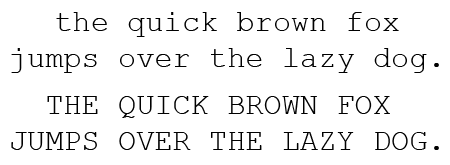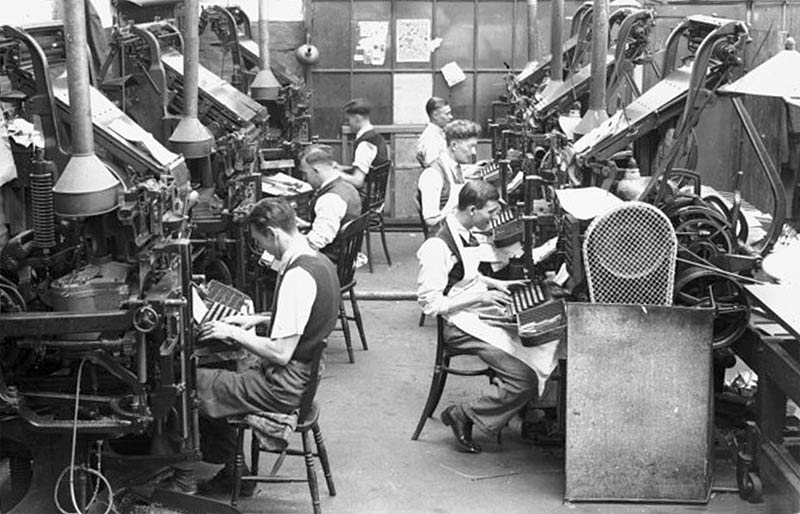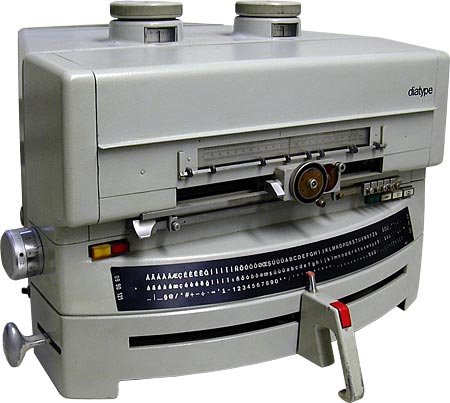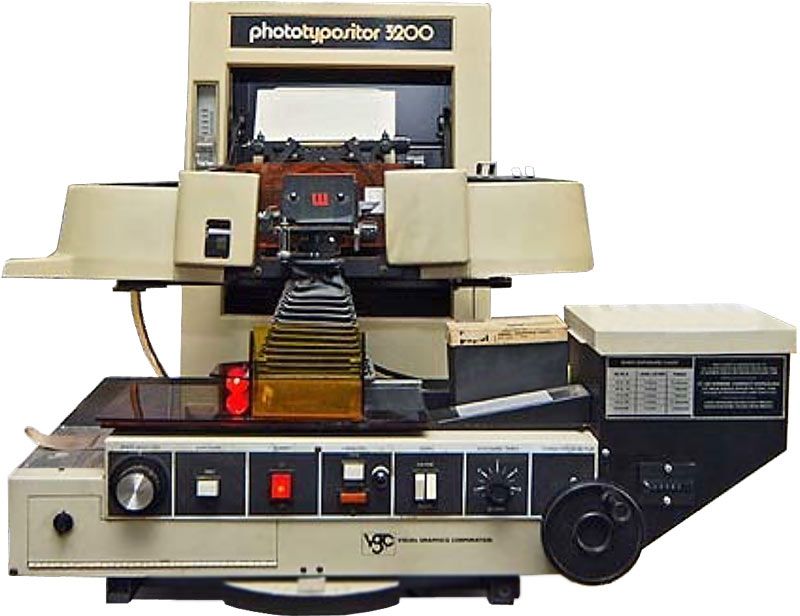1950
The A.B. Dick 350 is a small one color printing press which will remain in production in the US until 1986. This duplicator creates the business of quick printing.
1951
The first drupa trade show is held in Dusseldorf, Germany. drupa, which stands for ‘Druck und Paper’ (print & paper), is a specialist trade fair for the printing industry.
The Original Heidelberger Tiegel printing press is one of the highlights. Offset presses like the Roland Parva and Roland Ultra are demonstrated.
At the same show, five different models of Monotype and Linotype typecasting machines are on display. During the fifties, there are worldwide over 100,000 Linotypes in use.
The Photon 200 composer is launched that same year. This keyboard-based composer can output 16 fonts in sizes from 4 to 72 points. It is used for typesetting advertising texts for newspapers and for complex commercial printing jobs. The image below shows how this optomechanical device works. Light flashes generated by a strobe (not shown, to the right) pass through a rotating font disk containing all the characters of a font in reverse. To output an ‘M’ the system waits until the ‘M’ character on the rotating disk is in front of the flash, then the flash goes off and the disk only lets the light shaped in the form of that ‘M’ character through. This light goes through the lens turret that reduces or magnifies the character to the required type size. The light then gets deflected by a prism onto photographic paper. The optical system then moves to the right and the process is repeated to image the next character. Once an entire line has been photoset that way, the roll of photographic paper advances a bit so the next line can be imaged. Once an entire column of text has been imaged, the container holding the photographic paper is taken out of the machine and chemically developed in a dark room.
Dr.-Ing. Rudolf Hell GmbH develops the Klischograph, an electronic engraving machine for producing letterpress printing plates.
1953
The Wonderful World of Insects is the first book that is completely typeset using a Lumitype.
Only a few script typefaces are mentioned on this site, but Mistral could not be overlooked. It is designed by Roger Excoffon, who based it on his own handwriting. In lowercase, it is a true connecting script, similar to cursive writing.
1954
The Quincy Patriot Ledger is the first American newspaper that invests in photocomposition by installing Lumitype-Photon 200 systems. The machines, of which the output unit is equipped with a punch tape reader, glass type disks, and 12 lenses, are said to be three times more productive than hot-metal linecasters.
The Mergenthaler Linotype Company demonstrates a pre-production version of the Linofilm type-composing machine. The Linofilm consists of two parts, one containing a keyboard hooked up to a device to write punched tape, the other being the output unit. This unit contains a set of glass plates with a matrix of 88 characters inscribed on them. To compose text, characters from such a plate are exposed using an optical system that includes a shutter. This shutter, similar to the one used in the lenses of today’s digital cameras, consists of very thin, overlapping metal blades. Instead of always opening at the same point at the moment of exposure, it opens at the position of one of the characters on the glass plate. This mechanism is capable of producing 12 characters per second or 43,200 per hour. Optional units are available to still do text corrections on the punched tape and to increase the available font sizes up to 100 points.
3M introduces the Color Key overlay proofing system.
The second drupa fair is a major success with 226388 visitors during 16 days. The show highlights are engraving machines for letterpress printing. Grapha, which is now known as Muller Martini, exhibits its first fully automatic saddle stitcher with an in-line trimmer.
Addressograph-Multilith introduces the Multi-1250 press. Together with the AB Dick 350, it will dominate the small offset (duplicator) market in the years to come.
1955
Howard Kettler designs the Courier typeface for IBM. It is originally used for their typewriters but eventually also gets shipped with operating systems, such as Microsoft Windows 3.1, and with many RIPs.

Linotype typesetting in a newspaper in Norwich, England.
1956
The picture below shows the cutting edge technology of the day: a 5 MB IBM hard disk is shipped to a customer.
1957
The Univers typeface, designed by Adrian Frutiger and marketed by Deberny & Peignot and Monotype, is one of the first commercially successful fonts that was initially designed for use on Photon photocomposition machines.
Below you see the typeface on a Lumitype-Photon font disc.

Another classic typeface from that same year is Helvetica, created by Max Miedinger with input from Eduard Hoffmann. In the example below the reworked version from 1983 is used.
Letraset starts marketing dry transfer letters.
The Heidelberger Zylinder 54 x 72 cm is the bestselling book printing press of Schnellpressenfabrik AG Heidelberg.
Press manufacturer Harris-Seybold merges with Intertype Corporation. Harris-Intertype Corporation manufactures hot metal linecasters such as this Monarch from 1978.
Russell Kirsch makes the first digitized photo by creating a 176×176 pixel scan of a photograph of his three-month-old son. The computer used wasn’t capable of storing more information.
1958
H. Berthold AG, a German company, introduces its first typesetting equipment. The Diatype is a desktop-sized machine for setting headlines and short pieces of text. By moving a trigger on the front of the machine the operator can select characters from its glass font master disc. The system is nicknamed the ‘duck-shooter’ in the UK. Typesetting equipment gets a lot of attention during the drupa 1958 show.
Another drupa novelty is the Hell Colorgraph, a flatbed system to scan and correct photographs. With a resolution of 500 ppi a 30 by 40-centimeter scan can take hours.
Due to the success of their Roland presses the Franken & Schleicher factory is renamed to ‘Roland Offsetmachinesnfabrik Franken & Schleicher‘.
The Optima typeface, designed by German typeface designer Hermann Zapf between 1952-1955, is released. It becomes an instant success.

1959
The Lumizip 900 sets a new speed record by imaging 200 to 600 characters per second or more than 2,000,000 per hour. It reads the text off a magnetic tape. The first book composed with a Lumizip is the ‘Index Medicus’, which is imaged in 12 hours. Producing the same book on a tradition Linotype would have taken almost a year!
The Xerox 914 copier can make up to six copies per minute on regular paper. It is a major step forward compared to the Model A, the first copier from 1950, which still needed two to three minutes to make a single copy.
Visual Graphics Corporation (VGC) introduces the Photo Typositor, which was invented by Murray Friedel. This phototypesetting machine is used for setting display type, such as large headlines or text on posters. This machine and its successors, models 3000, 3100 & 3200, remain popular for over two decades.
The Haas Type Foundry in Switzerland releases the Helvetica font, designed by Max Miedinger and Edüard Hoffmann. Within a few years, this becomes one of the most popular typefaces of all time. The sample below is from the slightly reworked Helvetica Neue 55.
A.B. Dick’s Information Products Division rolls out the first inkjet printer, the Model 9600 Videojet, which is used for industrial marking applications and can print 250 characters per second. Printing date codes on cans and other types of packaging remains the main application of inkjet technology in the decade that follows.


















I found your site looking for a picture of the Compugraphic MCS but had no idea I would fall into a treasure trove. Having been blessed with a chance to start my journey into the graphic arts at 16 years old with an apprenticeship in 1980 at Typosatz Bauer in Stuttgart, I can say I go back quite a bit too. Typosatz Bauer had everything from a complete hand type department, the Neotype (a Russian knock-off of the Linotype line setter), and every incarnation of Berthold equipment from Diatype, Diatronic, Itek and the Berthold ADS and ACS for me to get my hands blackened with lead, sulfur stained from fixer and get a real good training. It was an amazing time and there was a deep reverence still for Gutenberg‘s invention from 600 years earlier. In 1984, true to the spirit of having become a journeyman, I hitchhiked to Silicon Valley, unbeknownst to me, since it’s not a place you find on a map and it was well before Google. Almost every photo in your blog evokes memories and stories. What an incredibly detailed and beautifully constructed website you created to allow one to take a trip down memory lane. And even for someone like me to learn new things, like Compugraohic connecting the Apple LISA to the 8400 a year before I arrived at Swan Graphics. Wow. We used a 300 baud modem in 1984 at Swan Graphics in Palo Alto to send text from the Mac to the MCS and from there to the 8400 and Connie, the owner taught our customers to use simple markup codes like $B for bold or $H2 for headlines to automate the conversion of wordprocessing documents From the IBN PC, the HP 150, the Mac and 400 other OS‘ via the Intermedia well before the Laserimagesetters and Adobe Atlas RIP. She was a true pioneer and I was fortunate to stumble upon Silicon Valley at the time… Ground Zeto of the Desktop Publishing revolution. And Photoshop 1.0. Thank you very much for all the research and building this site. What s trip.
The Multiliths 1250 had been around since World War 2. A older model with a Davidson feeder goes back to the mid 1930’s.
What a terrific tutorial. Great for research, such as the link to the NY Times photos in the Library of Congress. Thanks.
Anyone know what weight paper was used in the mid 50s for typewriters , recipes, invoices?
Thx
Ken
20 LB Bond
I guess I should have added that he purchased it used sometime in the late 50s. He was able to buy it because the company he worked for was buying new equipment.
Brad
Hi,
I’m trying to track down the brand of printing press that my dad used to use back in the late 50s and early 60s. All I know is it was an offset printing press, that was around 5′ to 6′ long, paper was loaded on the right end of the machine and inks were smeared on rollers in the upper middle/right of the machine. I’ve looked at some AB-Dick machines and the are at least similar in design but I dont think it was an AB-Dick machine. If I ever see a picture of it I will definitely recognize it.
Any suggestions on how to proceed?
Thanks,
Brad
odds are it was a MULTILITH 1250. they seemed to be in every place. however, your description could be just about any small offset duplicator.
Probably an Multilith 1250. The “Single Lever” model was introduced in about 1970. Earlier models were brown.
SOUNDS LIKE A MULTILITH 1250 PRESS. LOOK IT UP TO SEE PICS. IT MAY BE IT. GOOD LUCK. JOE
I have worked on Photons most of life in the printing business and now starting to collect printing history
Thanks
Charles Sweitzer
I started working for Photon April 1, 1968 in Wilmington, MA. I would be interested in learning about any information that you have about Photon.
I was wondering if you would know of any printing history collector that would like to have 2 photon glass discs? They look like the ones in your 1957 picture. Thanks,